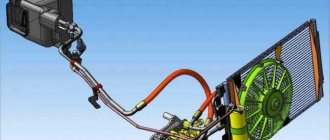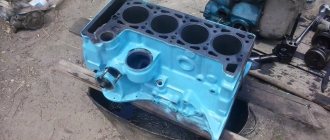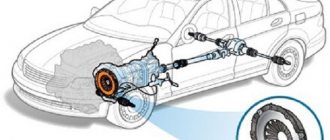In today's article we will talk about the cars of the Volzhsky Automobile Plant. Despite the emergence of new car models, experienced drivers still prefer to choose an “iron horse” based on its consumer ability: real and declared.
For example, the declared fuel consumption of the VAZ 21053 per 100 km is 9.1 liters. But in fact, fuel consumption on the Lada 21053 when traveling in the city is on average 8.1 liters, and outside the city - 10.2 liters.
Moreover, these are average figures that correspond to approximate mileage with engines of the same power. It is for their reliability and affordable price that Lada cars are loved.
| Engine | Consumption (highway) | Consumption (city) | Consumption (mixed cycle) |
| 1.5 l 5-mech | 5.2 l/100 km | 8.9 l/100 km | 7 l/100 km |
| 1.6 l 5-mech | 8.5 l/100 km | — | — |
| 1.3 l 5-mech | 9.5 l/100 km | 12.5 l/100 km | 11 l/100 km |
VAZ 2105 in detail about fuel consumption
In today's article we will talk about the cars of the Volzhsky Automobile Plant. Despite the emergence of new car models, experienced drivers still prefer to choose an “iron horse” based on its consumer ability: real and declared.
For example, the declared fuel consumption of the VAZ 21053 per 100 km is 9.1 liters. But in fact, fuel consumption on the Lada 21053 when traveling in the city is on average 8.1 liters, and outside the city - 10.2 liters.
Moreover, these are average figures that correspond to approximate mileage with engines of the same power. It is for their reliability and affordable price that Lada cars are loved.
| Engine | Consumption (highway) | Consumption (city) | Consumption (mixed cycle) |
| 1.5 l 5-mech | 5.2 l/100 km | 8.9 l/100 km | 7 l/100 km |
| 1.6 l 5-mech | 8.5 l/100 km | – | – |
| 9.5 l/100 km | 12.5 l/100 km | 11 l/100 km |
Work process: Main parts
| Fuel consumption of VAZ 2105 (Lada (VAZ) 2105) During the existence of the socialist camp, a large number of these cars were sent to states friendly to the Soviet Union, both for sale on the consumer market and for participation in rally racing. Before making adjustments, check the parallelism of the side surfaces of the float relative to the imprint of the walls of the float chamber on the cardboard spacer. |
- DAAZ. The Dimitrovgrad Aggregate Plant produced 2105 carburetors based on a license from the Italian Weber. One of the advantages of DAAZ carburetors is simple maintenance and repair. The plant produced not only carburetors, but also all the necessary elements for its repair or adjustment. If necessary, you can purchase any components in stores. The adjustment of the unit could be done by the driver himself. Dimitrovgrad carburetors provided the car with high dynamic characteristics. New fuel jets are selected so that the response to the gas pedal is very fast. Units with index 10 and also 20 were produced. One significant disadvantage of this particular modification is considered to be high fuel consumption. If the driver moved quite dynamically in the mixed cycle, then the car in this mode consumed from 10 to 14 liters of fuel per 100 km.
- "Ozone". Models from Ozon are a modified version of the unit from DAAZ. The difference between this carburetor is that it is a more advanced device. This model has higher environmental performance, and fuel consumption has been significantly reduced. A significant disadvantage of Ozone is the pneumatic valve, which is necessary to put the second chamber into operation. Because of him, many people had a lot of problems. The valve could not work adequately at the slightest contamination.
Causes of malfunctions and their elimination • Until now, the brand of this car remains popular among fans of Soviet classics.
Leakage problem: what threatens it and how to determine it
Many novice drivers wonder: why is so much attention paid to fuel consumption? If you have a carburetor, then increased fuel consumption not only hurts your pocket, but also indicates malfunctions and (or) improper care of the car. That is, if the standard fuel consumption for a 2105 in the city is no more than 10.5 liters, but it takes you 15, it’s worth thinking about. Perhaps there is a leak somewhere? You can view the standards in the technical specifications for your car.
If your car was purchased not in the 80s of the twentieth century, but later, then you have a solex type carburetor, which has little in common with the “ozones” with which the “career” of the Volzhsky plant began. These two types of carburetors differ only in the control system, but in essence their operation is one and the same.
What can determine the amount of fuel spent?
- Real gasoline consumption of a VAZ 2105 in the highway cycle with an engine power of 64 hp. is 9.5 liters at a speed of 120 km/h and 6.8 liters if the speed is up to 90 km/h. When driving around the city - 10.2 liters. The difference is the four-speed gearbox.
- Average gasoline consumption for a VAZ 2105 with a five-speed gearbox and an engine of 71.1 hp. on average 0.2 liters lower.
Solex carburetor 21053 20 calibration data
During the process of carburetor throttling, one can observe an unstable composition of the fuel mixture over time in the working charges; there is no cycle identity. This has a significant impact on the composition of exhaust gases. Also, the heterogeneous composition of the combustible mixture over cycles can be affected by three factors:
- the nature of the mixture distribution over the flow cross section;
- fuel dispersion;
- the nature of the mixture distribution along the flow.
The type of flow of the emulsion mixture from the channel of the main spray system can have a significant impact on the flow structure. Depending on the ratio of the productivity in the dosing jet system and the flow rate of the emulsion, the following types of flow can be obtained: laminar, plug, coarse emulsion, axisymmetric and wave.
Thus, depending on the change in the type of flow from the nozzle of the main emulsion system, the homogeneity of the composition of the fuel mixture in the operating cycles of the car engine will change significantly. The axisymmetric mode is the most optimal for stable operation of the car engine. This can be achieved thanks to a uniform fuel supply.
The air jets of the Solex 21083 carburetor allow you to adjust, together with the fuel jets, the optimal operation of the carburetor. It should be remembered that the location of the air jet of the main system inside the fuel-air main path is undesirable due to the possibility of clogging or tarring of the jet, which can lead to carburetor malfunctions.
This is often observed when engine crankcase gases pass through the carburetor. It is best to place the air jets in special pockets that will protect them from the effects of direct air flow.
In case of modification or tuning of the Solex 21083 carburetor, it is necessary to pay due attention to the selection of jets. This process should be carried out depending on the volume of the car’s engine. Thus, for large engine volumes, for example 1.5-1.7, it is best to use small jets.
Due to the large volume, a lot of air will pass through the diffuser per unit of time, and as a result, significantly more fuel will be consumed. Of course, if you are not going to pump up your car for fast driving, then this will not be so significant for you. Otherwise, it is better to install jets with a smaller cross-section.
Fuel consumption of VAZ 2105, 21051, 21053, 2104, 21043, 2107, 21074 cars
Below are the fuel consumption figures for rear-wheel drive VAZ 2105, 21051, 21053, 2107, 21074, 2104, 21043 cars with carburetor engines. Fuel consumption measurements were carried out on technically sound vehicles with a mileage of no more than 30,000 km.
At the same time, there were four people in the cabin (including the driver) and 40 kg of cargo in the trunk.
Fuel consumption standards for engines of VAZ 2104, 2105, 2107 cars
VAZ 2105
Engine 2105 1.3 63.9 hp/47 kW, four-speed gearbox
Highway: 90 km/h – 6.8 l/100 km
120 km/h – 9.5 l/100 km
City – 10.2 l/100 km
Engine 2105 1.3 63.9 hp/47 kW, five-speed gearbox
Highway: 90 km/h – 6.6 l/100 km
120 km/h – 9.1 l/100 km
City – 9.9 l/100 km
Engine 2101 1.2 l 58.7 hp/43.2 kW, four-speed gearbox
Highway: 90 km/h – 6.9 l/100 km
120 km/h – 9.7 l/100 km
City – 10.1 l/100 km
Engine 2103 1.5 l 71.1 hp/52.3 kW, four-speed gearbox
Highway: 90 km/h – 6.8 l/100 km
120 km/h — 9.3 l/100 km
City – 9.5 l/100 km
Engine 2103 1.5 l 71.1 hp/52.3 kW, five-speed gearbox
Highway: 90 km/h – 6.2 l/100 km
120 km/h — 8.6 l/100 km
City – 9.3 l/100 km
VAZ 2107
Engine 2103 1.5 l 71.4 hp/52.5 kW, four-speed gearbox
Highway: 90 km/h –6.9 l/100 km
120 km/h – 9.5 l/100 km
City – 9.6 l/100 km
Engine 2103 1.5 l 71.4 hp/52.5 kW, five-speed gearbox
Highway: 90 km/h –6.4 l/100 km
120 km/h – 8.6 l/100 km
City – 9.4 l/100 km
Engine 2106 1.6 l 74.5 hp/54.8 kW, four-speed gearbox
Highway: 90 km/h –6.8 l/100 km
120 km/h – 9.2 l/100 km
City – 9.6 l/100 km
Engine 2106 1.6 l 74.5 hp/54.8 kW, four-speed gearbox
Highway: 90 km/h –6.1 l/100 km
120 km/h – 8.4 l/100 km
City – 9.2 l/100 km
VAZ 2104
Engine 2105 1.3 l 63.9 hp/47.0 kW, four-speed gearbox
Highway: 90 km/h – 7.1 l/100 km
120 km/h - 9.9 l/100 km
City – 10.2 l/100 km
Engine 2103 1.5 l 71.1 hp/52.3 kW, four-speed gearbox
Highway: 90 km/h –7.3 l/100 km
120 km/h – 9.5 l/100 km
City – 10.3 l/100 km
Engine 2103 1.5 l 71.1 hp/52.3 kW, five-speed gearbox
Highway: 90 km/h –6.9 l/100 km
120 km/h – 8.9 l/100 km
City – 10.1 l/100 km
Five more articles on the site on fuel consumption by VAZ cars
Source: twokarburators.ru
Examples of savings in Moscow
For example, let's calculate two distances:
- From Red Square to the Moscow Ring Road and back in Moscow 50 km. How much gas does one save per month of such trips?
- From Moscow to Sochi - 1600 km. How much cheaper will it be to fill up with gas?
Savings after installing HBO
| Volume | Transfers | From Red Square to the Moscow Ring Road and back × month | From Moscow to Sochi and back | ||||
| Petrol | Gas | Saving | Petrol | Gas | Saving | ||
| 1.2 | Mechanics | 5 063 ₽ | 2 723 ₽ | 2 340 ₽ | 10 800 ₽ | 5 808 ₽ | 4 992 ₽ |
| 1.3 | Mechanics | 5 570 ₽ | 2 868 ₽ | 2 702 ₽ | 11 882 ₽ | 6 118 ₽ | 5 764 ₽ |
| 1.3 | Mechanics | 5 535 ₽ | 2 977 ₽ | 2 558 ₽ | 11 808 ₽ | 6 350 ₽ | 5 458 ₽ |
| 1.5 | Mechanics | 6 204 ₽ | 3 194 ₽ | 3 010 ₽ | 13 235 ₽ | 6 815 ₽ | 6 420 ₽ |
| 1.5 | Mechanics | 6 818 ₽ | 3 666 ₽ | 3 151 ₽ | 14 544 ₽ | 7 821 ₽ | 6 723 ₽ |
| 1.6 | Mechanics | 5 993 ₽ | 3 086 ₽ | 2 907 ₽ | 12 784 ₽ | 6 582 ₽ | 6 202 ₽ |
| Prices for a liter of gasoline and gas: 92 - 45.00 ₽, 95 - 47.00 ₽, CIS - 22.00 ₽. | |||||||
If you spend more than an hour a day driving a VAZ 2105, then gas equipment will pay for itself in less than a year. Calculate your monthly and annual savings on your mileage using the savings calculator.
Share with your friends how much they can save:
VAZ-2105
It is quite difficult to imagine a car enthusiast who is unfamiliar with the legendary VAZ-2105 model. Production of the latter began in the 80s. last century.
The first models were equipped with carburetor engines of different sizes and power:
- The 1.2 liter carburetor had a power of 59 hp. With;
- the 1.3 liter carburetor had a power of 69 hp. With.;
- 1.5 liter carburetor engines provided a power of 71 hp. With.
After 10 years, the manufacturer equipped the VAZ-2105 with a more powerful engine, with central fuel injection, which could reach speeds of up to 71 hp. s., its engine capacity was 1.5 liters.
The fuel consumption of a car of this brand depends on several factors:
- depending on the time of year;
- from the place of operation of the car, that is, the car is used in the city or outside its boundaries;
- on the number of traffic jams.
The average consumption in the city is 10 l/100 km, on the highway 7 l/100 km; if car owners have to stand in traffic jams for a long time while driving, especially in winter, then the consumption can increase to 15 l/100 km.
Why didn't the triumph take place?
The only drawback of the new engine was the short life of the timing belt. It was recommended to change it after 60 thousand km. In fact, the belts “died” even before this period. No catastrophe occurred, except for the fact that the car stopped where the break occurred. Experienced drivers carried a spare copy in the trunk, since replacing the VAZ 2105 timing belt was not too difficult.
Another reason why the engines were considered problematic was the shortage of spare parts characteristic of that time. VAZ 2105 pistons were interchangeable with 21011 parts that did not have counterbores. Sometimes unscrupulous mechanics, either deliberately or due to the lack of regular ones, installed the wrong components.
Naturally, when the belt broke, the valve plates and piston heads entered into a hard “clinch”, and the driver was forced to do a major overhaul of the engine.
A common drawback of all “classic” engines was the need to periodically adjust the valves, and in the first thousand kilometers, also tighten the cylinder head bolts. In addition, the attachments (water pump, starter, generator, distributor) had a short service life. The latter, however, has been absent in recent years due to the use of injection.
One of Murphy's laws states: if there is a part in a device that can be put in reverse, there will always be a person who will do it. This part turned out to be a remote plastic spacer for the fuel pump drive. Signs of its incorrect installation: the engine stalls during acceleration, in the heat, when driving with a lateral roll.
The mounting holes on the spacer flange are located asymmetrically, and the difference is almost invisible to the eye. This “jamb” was present on all “classic” engines, and perhaps migrated back to the FIAT 124. It happened that the spacer was installed upside down at the factory. At the same time, the engine was running, but the stroke of the fuel pump pusher decreased, which led to a decrease in its performance.
After a certain mileage, the level of gasoline in the float chamber barely covered the fuel supply nozzle, and the engine began to stall. Since the cause is quite unexpected, it can sometimes be difficult to determine.
Does fuel consumption change, taking into account the type of engine on the VAZ-2105
Many car owners would like to know: does gasoline consumption differ in VAZ-2105 cars that are equipped with a carburetor and an injection engine? Of course, the difference in fuel consumption is visible in the above cars, but it is insignificant. You can analyze this issue with a specific example:
- The VAZ-2105 1.3 carburetor consumes on average:
- in urban areas - 11.2 liters per 100 km;
- on the highway - 6.5 l;
- average fuel consumption – 8.2 liters.
- The VAZ-2105 1.5 injector consumes on average:
- in urban areas - 8.9 liters per 100 km;
- outside the city - 7.4 liters per 100 km;
- average consumption is 8.5 liters per 100 km.
Reviews from VAZ-2105 owners indicate that fuel consumption increases not only in winter, since additional gasoline is required to warm up the car, but also in summer, it all depends on the quality.
The better the quality of gasoline, the longer the car will travel on fueled fuel, and clean fuel without foreign impurities will not clog various automotive components, which over time can cause serious damage.
Financial life
ADJUSTING THE CARBURETOR FOR MINIMUM FUEL CONSUMPTION.
Carburetors manufactured on a factory assembly line, despite the fact that they undergo control regarding fuel supply characteristics, may differ from each other. Some carburetor samples differ from the average “reference” by 5–8% in fuel consumption, i.e. up to 10–16% from each other.
Based on this, in operation it is possible, through personal adjustment of the dosing units, to significantly reduce fuel consumption on the vast majority of serial carburetors.
Personal adjustment of the dosing units must be carried out in a certain sequence in order to eliminate the need to re-adjust the previously adjusted unit after the intervention in the adjustment of another system is completed.
To do this, first of all, they slowly reduce the adjustment of the main metering system of the primary chamber, then regulate the idle speed system, and only then control the operation of the carburetor under enormous loads with the opening of the secondary chamber.
In order to avoid making fuel jets of reduced capacity, it is possible to achieve leaner adjustment of the main metering system of the primary chamber by increasing the air jet.
As a rule, it is not uncommon to install a 1.8 millimeter air jet on the first chamber of the VAZ 2105 carburetor, and 1.6 millimeters on the VAZ 2107 carburetor.
If, after the end of the increase in the air jet during smooth acceleration of the car from 60 km/h in direct gear with the damper of only the primary chamber opening, an obviously noticeable long (2–3 s) delay in increasing the crankshaft speed appears, then with confidence in the proper operation of the accelerator The pump should be directed to install an air jet with a smaller (0.05 or 0.1 mm) steam section.
Is it possible to reduce fuel consumption yourself?
The above comparative characteristics of carburetor and injection engines prove that there is a difference in fuel consumption between these engines, but it is relatively small. If a car owner still wants to independently reduce the consumption of a carburetor engine, which will reduce gasoline consumption by approximately 1.5 l/100 km, then this operation should be carried out in stages:
- In the main, that is, in the first metering chamber of the carburetor, you need to increase the size of the air nozzle. Professionals in their field talk about this process in detail in a training video that you can watch at a time convenient for you.
- Next you need to adjust the idle speed. For this operation you will need a special screw, which is called a “tuning” screw, with its help you need to check the operation of the engine in idle gear. If no so-called dips are observed when idling, the screw is simply screwed back in and the adjustment can be considered complete.
- Finally, it is checked how the carburetor engine operates in various modes.
A properly carried out tincture, which any car owner can do, taking into account the advice of professionals, will help reduce gasoline consumption to 1.5 l/100 km. And you can find any answer to a question on this topic on the Internet resource by watching a training video lesson.
Source: ladaautos.ru
Operation and repair of the device
The carburetor serves to form a combustible mixture by combining injected fuel and air, in order to ensure the operation of the internal combustion engine. In this case, the correct proportions must be observed to ensure normal combustion. If the proportions are not observed, an over-enriched mixture is formed due to an excess amount of fuel or lack of air, which leads to breakdowns.
The carburetor includes a system that maintains the required fuel level; a system responsible for starting and warming up a cold engine; idle system; main dosing system; acceleration pump; econostatic system. Adjusting the idle speed of the VAZ 2105 should be performed exclusively on the engine, which is warmed up in advance. The temperature value of the coolant should fluctuate around 90-95 degrees.
In addition, you need to adjust the gaps on the gas distribution mechanisms and open the air damper. Special attention should be paid to the correct setting of the ignition timing. When adjusting carburetor 2105, first of all, set the crankshaft rotation frequency to 700-800.
This process is carried out by means of a screw that regulates the composition of the mixture, after which the same screw achieves a carbon monoxide concentration of approximately 0.05.2% reduced to 20 ° C and 760 mm Hg. Art. with the screw in the above position. After this, using the first screw, you need to restore the crankshaft rotation frequency to 700-800. Using the second adjustment screw, the carbon concentration value can be restored as a percentage to 0.05.Jan.2.
Then, by sharply pressing the throttle drive pedal and then releasing it, the engine will increase the crankshaft rotation frequency, and if it decreases, the engine will stall. In this case, using the first screw, you should again increase the rotating frequency to 750-800, after which a plastic plug is installed in the hole for the second adjusting screw. After all these steps, the adjustment process 2105 is considered complete.
When installing a carburetor on a classic VAZ 21053, you should remember that, unlike the VAZ 2105, 21053 20 has a somewhat poor second chamber. This is explained by the fact that the first has a fairly rich adjustment. It can be made poorer by installing 102-150 jets, but then there will be a need to enrich the second chamber by installing 115-135 jets.
Considering the technical characteristics of the VAZ 2105, of course, it is necessary and more advisable to install the 2105 Ozone carburetor, but still, installing the 21053 20 carburetor is also considered acceptable. In order to increase engine power and the efficiency of the VAZ 2105 carburetor, a compressor is usually installed on the car.
The effectiveness of this method lies in the fact that when a compressor is installed, the charge of the fuel-air mixture increases. The mixture enters the cylinder due to increased air supply to the fuel system. The compressor has not only advantages, but also disadvantages, one of which is increased fuel consumption.
The compressor consists of a pulley, a drive gear, a rotor driven gear and an internal oil gear. All installation work should be carried out with the engine cool. After installation, the compressor should have minimal resistance to air movement. Typically, an installation kit is used for this, which includes all the necessary parts. A mechanical supercharger (compressor) plays an important role in the process of improving the quality of a car.
Fuel consumption VAZ 2105
Those who do not take risks do not park under the windows
The VAZ 2105 is a record holder, as it was produced for the longest time of all Soviet-Russian cars - 31 years. The first car rolled off the assembly line in 1979, and the last in 2010. At the beginning of the 21st century, it was the cheapest car, the cost of which did not exceed 180 thousand rubles.
Official data (l/100 km)
| Engine | Consumption (city) | Consumption (highway) | Flow (mixed) |
| 1.2 MT 64 hp (Mechanics) | 10.0 | 6.3 | 7.5 |
| 1.3 MT 63 hp (Mechanics) | 9.4 | 6.9 | 7.3 |
| 1.3 MT 64 hp (Mechanics) | 9.4 | 6.9 | 7.3 |
| 1.3 MT 140 hp (Mechanics) | 10.2 | 6.2 | 7.9 |
| 1.5 MT 71 hp (Mechanics) | 9.6 | 7.4 | 8.8 |
| 1.5 MT 75 hp (Mechanics) | 10.3 | 7.4 | 10.1 |
| 1.6 MT 73 hp (Mechanics) | 10.1 | 6.8 | 8.5 |
| 1.6 MT 74 hp (Mechanics) | 9.6 | 7.1 | 8.5 |
| 1.5 MT 50 hp diesel (mechanics) | 6.7 | 5.8 | 6.1 |
The legendary classic was equipped with four different gasoline engines, as well as one diesel engine. The first petrol unit is 1.2 liters. Its power was 64 horsepower, and a carburetor was responsible for supplying fuel. Fuel consumption per 100 km of this configuration was registered at 7.6 liters.
The next engine was 1.3 liters, the power of which was also 64 horsepower. The carburetor was also responsible for fuel here. There was also a special version with a rotary engine, the peak power of which was as much as 140 hp. Gasoline consumption here varied from 7.6 to 7.9 liters.
The first power plants, where an injector was installed, had a volume of 1.5 liters. The power of this version was 71 horsepower, and the consumption was 8.9 liters. The highest consumption was in the version with the 1.6 liter engine. With a power of only 74 hp, it consumed up to 9.1 liters of fuel. Both a carburetor and an injector could be installed here.
The diesel representative had a volume of 1.5 liters and developed only 50 horsepower. However, its consumption was at 6.1 liters. All power plants were controlled by five-speed manual transmissions.
Adjusting the float system. basic information
When the float rises, the fuel flow decreases; when you sharply press the gas pedal and open the throttle, the fuel consumption increases and the float drops. Basically, the Ozone 2105-1107010-20 carburetor differs from the Ozone 2105-1107010-10 carburetor in the difference in the diameter of the main fuel nozzle of the primary chamber and the additional pipe connected via a hose to the vacuum regulator of the ignition distributor.
| GENERAL INFORMATION |
Owner reviews
“I always thought that our cars should not be used at all. But after the crisis began, I had to sell my favorite foreign car and buy something cheap, that is, our car. I chose the five because in terms of price/quality ratio it was more or less. Naturally, it is equipped with only the most necessary functions for movement. The design is sparse, but the body is made as if from armor. It's impossible to break through. The engine is rather weak, but it consumes less fuel than my old car. The maximum I got was 12 liters, but that was in the winter, otherwise no more than 10,” writes Nikolai from Penza.
“As soon as I got my license, I started thinking about buying some kind of car that I wouldn’t mind killing. I immediately dismissed all options with foreign cars and focused on finding a good representative of our automobile industry. I chose the five because it is not expensive, and the equipment is not very different from other models. I drove it for about five years, during all that time I never had it repaired, except for small things. It is poorly equipped, but it is assembled with high quality. The engine is well suited for the city, but rather weak for the highway. It’s bad that the car has high consumption – about 12 liters,” says Grigory from Smolensk.
“I got the car from my father. I drove it for a couple of years and decided to sell it, since I spent a lot of money on it. And it’s not a matter of repairs, everything was fine here, but a matter of gasoline consumption. A small one and a half liter engine eats as if it were a six liter one. Moreover, its power is clearly less than stated in the passport, but it quickly consumed its 16 liters. I don’t want to deal with our cars anymore,” wrote Denis from Kostroma.
“I believe that only a very rich and brave person can own this car. It often breaks down, is very poorly equipped, looks terrible, I’m generally silent about the engine, it’s barely strong enough to just move around the city. But what bothers me the most is the huge fuel consumption. In the city it can reach 15 liters, and in the summer. In winter the situation is still good - about 17 liters. On top of all this, it’s impossible to start the car; you have to tinker with the engine for a very long time,” this is the review left by Kirill from Desnogorsk about this car.
“I read a lot of reviews about this car and almost everyone doesn’t like the fact that it consumes a lot of fuel. Why I don't have this problem, I don't know. My one and a half liter power unit spends no more than 10 liters, and it always works stably, never stalls and starts the first time in any weather. People also complain about poor equipment and poor appearance. Well, what did they want from a classic for a ridiculous price? The main thing is that it drives at least somehow, this is the main thing in our cars. For comfort, you can find a foreign car,” said Vladislav from Nizhny Novgorod.
“While I was driving a VAZ 2105, I realized that our cars are not so bad. Yes, their design leaves much to be desired, as does the interior design. But everything is done with high quality, with the expectation of long-term use without repair. In the almost 10 years that I have used the car, I have never been to a service center to repair the chassis, transmission or engine. Only consumables were changed, the main thing is proper and timely care and then you won’t kill the car at all. The only thing I didn’t like was fuel consumption, which reached 14 liters. I solved this problem with firmware,” writes Andrey from Ivanovo.
Source: driverstalk.ru
VAZ fuel consumption.
VAZ fuel consumption is always acceptable. The developers are seriously thinking about reducing fuel consumption for different VAZ brands.
VAZ cars are domestically produced cars. VAZ is a Volga automobile plant, it is located in the Samara region in the city of Tolyatti. VAZ cars are distinguished by moderate fuel consumption and affordable prices.
Data on VAZ fuel consumption are described below in the table on fuel consumption of VAZ cars. VAZ cars are not only a means of transportation, but also an integral part of everyday human life.
Fuel consumption of a VAZ depends on its modification (brand), driving style and time of year. The table below shows the average fuel consumption of the VAZ brands of the 2107, 2114, 2110, 2106, 2112, 2109, 2115 family.
Table of fuel costs for VAZ brands.
The table describes the average costs for different VAZ brands . Fuel consumption is presented in three types - city, highway and mixed (average) fuel consumption. All data on fuel costs are from the VAZ car manufacturer. For almost all brands of VAZ cars, fuel consumption does not exceed 10 liters per 100 km, with the exception of the carburetor Niva.
Average fuel consumption VAZ
liter/100 km
120 km/h=10
120 km/h=9.8
| Brand VAZ | Power, hp | City | Route | |
| VAZ 2101 (1.2, carburetor) | – | 10.5 | 11 | |
| VAZ 2102, 2103 (1.5, Carburetor) | 71 | 11 | 11.5 | |
| 2106 (1.57 engine, carburetor, four-speed gearbox) | 76.4 | 9.5 | 10.5 | 8.5 |
| 2106 (1.45 engine, carburetor, four-speed gearbox) | 73.5 | 9.9 | 10.8 | 9.0 |
| 2106 (engine 1.6, injector) | – | 8.4 | 9.8 | 7 |
| 2105 (1.3, carburetor) | 64 | 9.1 | 10.2 | 8.1 |
| 2105 (1.5, carburetor, four-speed gearbox) | 71.1 | 8.8 | 9.5 | 8.0 |
| 2107 (1.6, injector) | – | 7.8-9.8 | 9-11.5 | 6.7-8.2 |
| 2107 (1.6, carburetor) | – | 8.9 | 10.2 | 7.5 |
| 2107 (1.5, carburetor) | – | 8.3 | 9.6 | 7.0 |
| 2108, 2109, 21099 (1.5, carburetor) | 72 | 9.1 | 10.1 | 8.2 |
| 21083, 21093, (1.5, injector) | 72 | 7.6 | 8.5 | 6.7 |
| 2110, 2111, 2112 (1.5, carburetor) | 67.7 | 9.5 | 10.5 | 8.4 |
| 2110, 2111, 21124 (1.5, injector) | 72 | 7.9 | 8.7 | 7.0 |
| 2113, 2114, 2115 (1.5, injector) | 72 | 7.6 | 8.5 | 6.7 |
| Lada Granta (8 valve) | 80 | 7.0 | 8.3 | 5.8 |
| Lada Granta (8 valve) | 90 | 7.7 | 9.3 | 6.1 |
| Lada Granta (16 valve) | 98, 106, 120 | 8.1-10.1 | 9.2-11.2 | 7-9 |
| Lada Kalina 21117, 21118, 21119 (1.4 engine) | – | 6.9 | 7.8 | 6.0 |
| Lada Kalina 21118, 21119 (engine 1.6) | – | 7.2 | 8.1 | 6.3 |
| Lada Priora (1.6) | 90 | 7.6 | 8.8 | 6.5 |
| Lada Priora (1.6, 16 valve) | 106 | 8.6 | 9.5 | 7.7 |
| Lada Vesta 21179 (1.8, 16 valve) | 123 | 8.5-10.5 | 9.5-11.5 | 7.5-9.5 |
| Lada Vesta 21129 (1.6, 16 valve) | 106 | 8-10 | 9.0-11.0 | 7.0-9.0 |
| Lada x-Ray (X-ray, 1.6, 16 valves) | 110 | 7.9 | 8.8 | 7.0 |
| Lada x-Ray (X-ray, 1.8, 16 valves) | 122 | 8.1 | 9.1 | 7.2 |
| Lada Largus (1.6, 8 valve) | 90 | 8.6 | 9.5 | 7.7 |
| Lada Largus (1.6, 16 valve) | 105 | 8.2 | 9.0 | 7.5 |
| VAZ 21213 (Niva, 1.7, carburetor) | – | 11.5 | 13.0 | 10.0 |
| VAZ 21214 (Niva, 1.7, injector) | – | 9.8 | 11.0 | 8.5 |
| VAZ 2131 (Niva, 1.8, injector) | – | 11.1 | 12.8 | 9.5 |
VAZ has acceptable fuel consumption!
The car is given good dynamics and acceptable fuel consumption thanks to its reliable engine. VAZ has an affordable price for both a new and an old car. Old VAZ brands are acceptable to most people. The new VAZ engine demonstrates extreme efficiency, thanks to which the car has low fuel consumption and a reduced level of harmful emissions into the atmosphere.
VAZ - average quality cars, affordable price and acceptable fuel consumption.
What could cause increased consumption at VAZ?
1. Increased VAZ fuel consumption is observed in cars with a worn out engine. High piston wear will increase fuel consumption of any VAZ brand. Wear is determined by measuring compression in the VAZ engine block. If the compression is low, the piston needs to be replaced (rings, piston, block boring).
2. The increased flow rate is influenced by the coolant temperature, throttle position, mass air flow and detonation sensors.
3. High fuel consumption in VAZ cars is observed when the accelerator drive is faulty, the wheel alignment is adjusted correctly, or tire pressure is reduced.
4. An increase in fuel consumption in VAZ cars with carburetor engines is observed when there is a problem with the carburetor. These are holes in the diaphragms, incorrect adjustment of the choke cable, enlarged fuel jets, mixing up of air jets in two working chambers (chamber 1 = 165 mm, chamber 2 = 125 mm).
Timely completion of technical inspection will allow VAZ to maintain fuel consumption at the level declared by the manufacturer.
Source: pro-avto.su
Fuel consumption VAZ 2105 (Lada (VAZ) 2105)
Real fuel consumption on VAZ 2105 cars. Fuel consumption standards for Lada (VAZ) 2105 and actual data from VAZ 2105 owners. How to reduce fuel consumption - reviews from owners. Gasoline consumption and diesel consumption comparison table.
Select the model and modification below:
| Modification | Recommended fuel | Consumption in the city | Highway consumption | Mixed cycle |
| 2105 / 2105 1.3 MT (64 hp) (1980) | AI-92 | 10.2 l | 6.2 l | 7.9 l |
| 2105 / 21050 1.3 MT (64 hp) (1980) | AI-92 | 10.2 l | 6.2 l | 7.9 l |
| 2105 / 21051 1.2 MT (64 hp) (1981) | AI-92 | 10 l | 6.3 l | 7.5 l |
| 2105 / 21053 1.5 MT (75 hp) (1980) | AI-92 | 10.3 l | 7.4 l | 10.1 l |
| 2105/21053-20 1.5 MT (71 HP) (2005) | AI-92 | 10.3 l | 7.4 l | 10.1 l |
| 2105 / 21054 1.6 MT (73 hp) (2005) | AI-95 | 10.1 l | 6.8 l | 8.5 l |
| 2105/21054-30 1.6 MT (74 HP) (2005) | AI-92 | 10.1 l | 6.8 l | 8.5 l |
| 2105 / 21055 1.5d MT (53 hp) (1999) | diesel fuel | 5.7 l | 3.8 l | 5.6 l |
| 2105 / 21058 1.3 MT (63 hp) (1982) | AI-92 | 10.2 l | 6.2 l | 7.9 l |
| 2105 / 21059 1.3 MT (140 hp) (1980) | AI-95 | 10.2 l | 6.2 l | 7.9 l |
Owner reviews:
#29 Botanik Skoda karoq
| VAZ 2105 in detail about fuel consumption rpm 71 Tax on VAZ Lada 2105 Maximum torque, Nm rpm min 112 3500 Mechanical type 5 Rear wheel drive Front wheels independent, spring Rear wheels dependent, spring Tire size 175 70 Wheel size R13 Front disk Rear drum Urban cycle 9. Sometimes motorists give advice on how to save on RT, but not all the proposed methods work, and often savings in such ways turn out to be dubious. |
- in suburban mode - 7.3 l;
- in the city - 9.7 l;
- in mixed mode - 8.5 l.
Toyota RAV4
Greetings! I want to share my impressions of the new Toyota RAV4 2019 model 2022. Until then.
Dealer news:
New cars and used cars - tens of thousands of ads for sale. Reviews from car owners. Technical characteristics and accessories. Comparison of models and Test Drives. News from the world of cars. Prices for new cars. Promotions and special offers from car dealerships. We will help you make your choice!
This site is for informational and reference purposes only and under no circumstances constitutes a public offer.
Certificate of registration of mass media EL No. FS77-68106 dated December 21, 2016. Issued by the Federal Service for Supervision of Communications, Information Technologies and Mass Communications. 16+
Source: www.njcar.ru
How to find out your gasoline consumption level
In a similar manner, the tax base is determined for excisable goods, in respect of which ad valorem tax rates are established as a percentage, when they are sold on a gratuitous basis, when carrying out barter transactions, as well as when transferring excisable goods under an agreement on the provision of compensation or novation and the transfer of excisable goods with payment in kind, etc. How much fuel a car consumes during operation is an exciting question for every car owner, given the difficult economic situation that is currently observed in our country.











